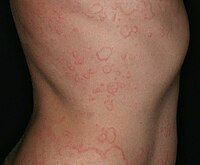
Photo from wikipedia
Purpose Data specific to the epidemiology, clinical features, and management of chronic urticaria (CU) in the geriatric population remain limited and not well understood. We aim to systematically review the… Click to show full abstract
Purpose Data specific to the epidemiology, clinical features, and management of chronic urticaria (CU) in the geriatric population remain limited and not well understood. We aim to systematically review the prevalence, clinical manifestations, treatment, and clinical course of elderly patients with CU. Patients and methods Original articles that included data of elderly (aged >60 years) with CU that were published until February 2021 were searched in PubMed, Scopus, and Embase using predfefined search terms. Related articles were evaluated according to Preferred Reporting Items for Systematic Reviews and Meta-Analyses recommendations. Results Among the included 85 studies and 1,112,066 elderly CU patients, most (57.4%) were women. The prevalence of elderly CU in the general population ranged from 0.2–2.8%, and from 0.7–33.3% among all CU patients. Compared to adult CU, elderly CU patients had a higher percentage of wheal alone (73.9%), and lower rate of positive autologous serum skin test and atopy. Gastrointestinal diseases were the most common comorbidity (71.9%), and there was a high rate of malignancies and autoimmune diseases. Second generation H1-antihistamines were commonly used, and achievement of complete control was most often reported. Omalizumab was prescribed in 59 refractory patients, and a significant response to treatment was reported in most patients. The treatment of comorbidities also yielded significant improvement in CU. Conclusion Elderly CU was found to be different from adult CU in both clinical and laboratory aspects. H1- antihistamines are effective as first-line therapy with minimal side-effects at licensed doses. Treatment of secondary causes is important since the elderly usually have age-related comorbidities.
Journal Title: Journal of Asthma and Allergy
Year Published: 2022
Link to full text (if available)
Share on Social Media: Sign Up to like & get
recommendations!